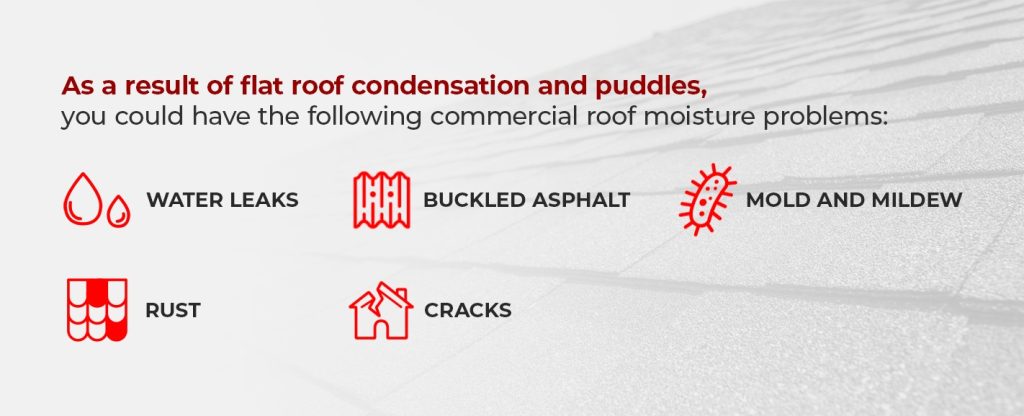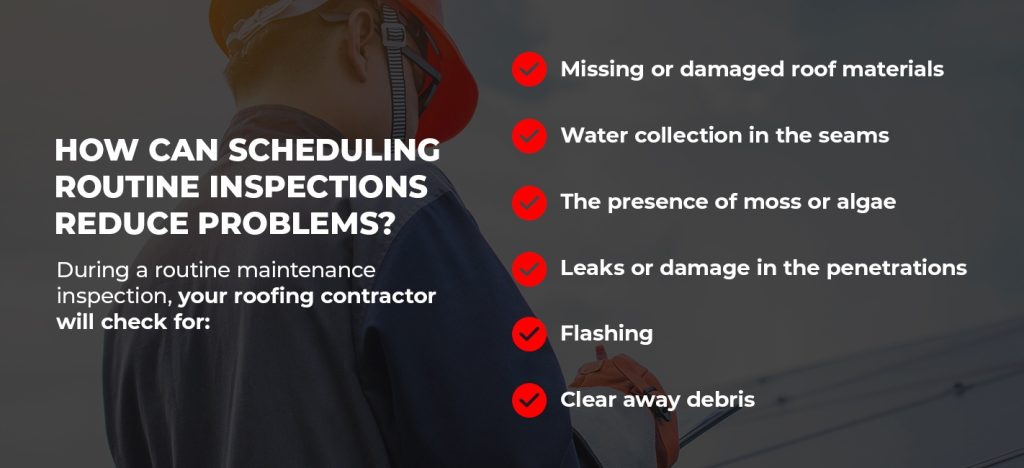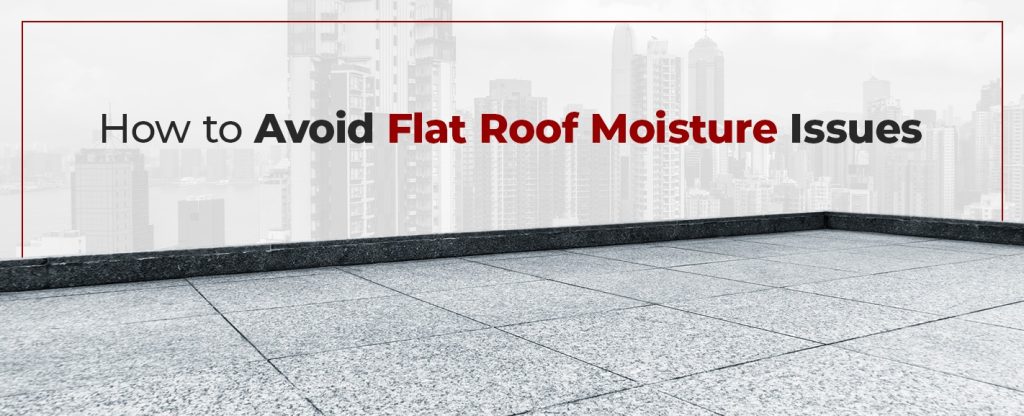
Why Are Flat Roofs More Likely to Have Moisture Damage?
Flat roofs are more likely to have moisture damage than sloped ones because they don’t always have an adequate way to drain the water off their surfaces. Even though your roof has a slight slope to allow water to drain, it may have difficulty keeping up with heavy rains, so water could pool on top of your building. As a result of flat roof condensation and puddles, you could have the following commercial roof moisture problems:
- Water leaks: When combined with excessive sunlight, standing water can tear through your roof and leak into your interior business area. If the water was on top of your roof for a long time, it might have also grown mold or bacteria that could damage your property and affect your employees’ health.
- Buckled asphalt: Shingles made with an asphalt membrane coating hold the seal over your flat roofs. Over time, this component moves to accommodate the shifting foundation, so your roof could lose its resistance to moisture and UV damage.
- Mold and mildew: Bacteria and other fungi can grow if you don’t deal with the standing water on your roof after a few days. You might even notice plants and weeds growing if dirt from a fallen tree is mixed in with the giant puddles.
- Rust: Prolonged exposure to water can corrode the metal components of your commercial roof.
- Cracks: Flat roofs have more exerted pressure than sloped roofs, so your roof is more likely to crack, especially under heavy water. Fractures in your roof could bring in air drafts and even potential rodent infestations in addition to moisture.
Why Flat Roofs Are Hard to Ventilate
Flat roofs are hard to ventilate because they lack the attic space pitched roofs have that more easily vent to the outside. Ventilation improves the building’s thermal efficiency by exhausting hot air and preventing condensation from forming under the roof. Buildings with flat roofs don’t typically have this ventilation capability, so it’s harder to cool the building, which increases the risk of moisture damage.
Flat roof ventilation provides the following benefits for your commercial roof:
- Extends your building’s lifespan: Weather-related problems such as ice damming in the winter can bring unwanted water onto your heated roof. Proper ventilation on the roof lets the warm air escape before it melts the ice and snow on top of your commercial building. In the summer, the ventilation helps prevent heat buildup in the attic by giving the warm air a place to escape. By regulating the temperature of your roof, you can extend its lifespan.
- Lowers your energy bills: When you have the proper ventilation on your roof to release the hot air in your building, you ease the pressure on your HVAC system. Since your air conditioner won’t have to run as long, you won’t have to pay as much in utilities.
- Makes your interior space more comfortable: Your commercial space should be warm in the winter and cool in the summer. Since warm air rises, your upstairs rooms might be uncomfortable if you don’t have the proper ventilation. Once you ventilate the roof, hot air can leave the building and make room for a cool breeze from the HVAC system into the attic.
Keep Your Flat Roof Clear of Debris
Prevent moisture damage and other problems by keeping debris off your flat roof. The top of your commercial building has a slight slope to allow rainwater to flow into drains around the building’s sides. Foliage and other debris can clog the gutters, causing water to collect on top of the roof. After several days, a pool of water can develop mold or even make your roof collapse.
Maintain your flat roof by:
-
- Cleaning and inspecting your gutters frequently: Debris can block the irrigation system that brings rainwater off your flat roof, especially in the autumn. Check them and install a leaf guard to keep track of falling leaves and other debris. Perform a regular maintenance inspection to make sure water doesn’t pool on your roof.
- Sweeping leaves and dirt off the roof: Leaves and branches can fall onto a flat roof and cause saplings to grow. Regularly sweep the top of your roof to prevent unnecessary growth.
- Sealing your roof with waterproof coating: Most shingle materials are porous, so if you don’t have the proper drainage, your roof is more vulnerable to leaks and mold. Applying a waterproof sealant can prevent your flat roof from experiencing water damage. When you have your roof inspected, ask them about installing your new roof with waterproof protection or watertight materials.

How Can Scheduling Routine Inspections Reduce Problems?
It’s best to get your roof inspected by a professional twice a year — once in the summer and the winter — to make sure a small problem doesn’t escalate to costly damage. During the inspection, they’ll check for cracks around raised edges that could cause leaks and drafts. Most roof warranties require you to get your roof inspected by a professional, so you could risk voiding your warranty if you don’t take care of this service.
During a routine maintenance inspection, your roofing contractor will check for:
- Missing or damaged roof materials: The components of your roof protect your commercial building from various weather conditions. If they’re missing or broken, they leave the rest of the structure vulnerable to water or UV damage. During a routine inspection, a professional can notice any broken seals or components that you may not see from the inside.
- Water collection in the seams: A professional roofing contractor will inspect the parts of your roof where the materials come together. Most of the time, these areas have seals around them, but they’re still vulnerable to leaks.
- The presence of moss or algae: Moss and algae on your roof can spread and break down the building’s structural components. If algae has accumulated on your roof, a professional contractor can clean it off as part of their services.
- Leaks or damage in the penetrations: Most commercial roofs have AC units, plumbing vents, air vents or skylights sticking out. Your roofing contractor needs to cut the roofing material to fit around them. These components are vulnerable to leaks because they’re not flat, so you should have them inspected during your routine maintenance appointment.
- Flashing: Roofing contractors install metal pieces where two roof components join together. Your contractor will check this part to make sure it keeps water from leaking into the building.
- Clear away debris: Besides checking for damaged parts, a professional contractor will remove the leaves and trash around your roof, gutters or downspouts. They’ll reattach loose components and repair or replace sealing and caulking.
After checking these various components of your roof, a professional will offer solutions to fix or prevent extensive water damage. They may also suggest a full roof replacement to prolong your commercial building’s lifespan and enhance its curb appeal.
Request a Free Quote for Flat Roof Repair in Deleware, Maryland or Virginia
Our professionals at Tiger Roofing seek to bring your flat commercial roof back to life with our commercial roofing services. We provide inspections and full roof replacements for commercial buildings in the DelMarVa area.
